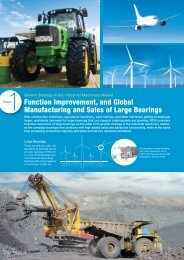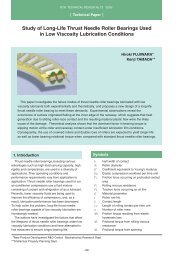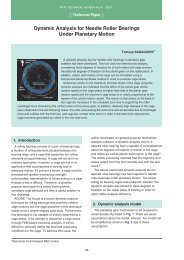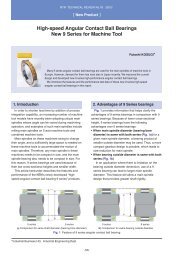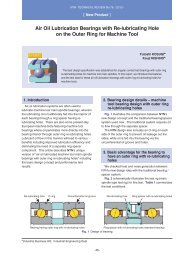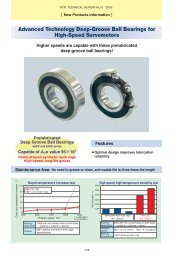Special Issue; Products for Industrial Machinery - NTN
Special Issue; Products for Industrial Machinery - NTN
Special Issue; Products for Industrial Machinery - NTN
Create successful ePaper yourself
Turn your PDF publications into a flip-book with our unique Google optimized e-Paper software.
<strong>NTN</strong> TECHNICAL REVIEW No.742006<br />
Moldability index<br />
Lower Higher<br />
Moldability index<br />
Lower Higher<br />
Moldability index<br />
Lower Higher<br />
Lower<br />
<br />
Higher<br />
Water content wt%<br />
Fig. 13 Water content and briquette strength<br />
Lower <br />
Higher<br />
Carbon content wt%<br />
Fig. 14 Carbon content and briquette strength<br />
Lower <br />
Higher<br />
Molding pressure MPa<br />
Fig. 15 Moulding pressure and briquette strength<br />
Moldability index<br />
Lower Higher<br />
Small <br />
Large<br />
Molding speed mm/sec.<br />
Fig. 16 Moulding speed and briquette strength<br />
pressure <strong>for</strong> the briquette, the necessary <strong>for</strong>mation<br />
strength can be obtained <strong>for</strong> the briquette. A lower<br />
<strong>for</strong>mation speed is advantageous in attaining a higher<br />
briquette <strong>for</strong>mation strength. However, the authors<br />
have selected an appropriate <strong>for</strong>mation speed in<br />
consideration of the throughput of the briquetter.<br />
3) Briquetter configuration<br />
After the pellets are loaded into the inlet hopper, a<br />
cycle consisting of metering, water spraying, loading<br />
into the die, <strong>for</strong>mation and discharge is executed<br />
automatically. Through setup <strong>for</strong> optimal briquetting<br />
conditions and rationalized machine design, stable<br />
briquette strength and higher productivity are attained.<br />
The major technical data <strong>for</strong> the authors’ EAF dust<br />
briquetter are summarized in Table 1.<br />
Table.1 Main specification of dust moulder<br />
Model HDM-150<br />
Pellets consisting of EAF dust, blended with<br />
Base materials carbon and water<br />
Briquette size Dia. 150 mm x 120 mm H, approx. 6.5 kg<br />
Cycle time 17 sec<br />
3600 W x 5550 D x 4300 H (mm);<br />
Machine size<br />
weight: approx. 1500 tons<br />
Throughput 800 tons/month (24 hours/day operation <strong>for</strong> 30 days)<br />
Power supply 200 V, 3-phase, 50 kVA capacity<br />
3.3 Advantages of the authors’ technology<br />
1) A pelletizing technology to produce pellets by<br />
adding a measured amount of carbon and water to<br />
the EAF dust, useful in obtaining briquettes of<br />
stable mechanical strength (patent pending).<br />
2) This technology provides reliable briquetting of the<br />
pellets (patent pending).<br />
3) The briquetter can be directly connected to the<br />
pelletizer to establish a fully automated briquetting<br />
system.<br />
4) Non-processed EAF dust is not loaded into the<br />
furnace. This helps improve the working<br />
environment.<br />
3.4 Benefits from adoption of the authors’ briquetter<br />
1) Prevention of EAF dust from being emitted as<br />
industrial waste and reuse of iron resources<br />
Helps achieve zero emissions<br />
2) Elimination of binder expenses, as well as the fees<br />
<strong>for</strong> commissioning briquetting work to an outside<br />
agent<br />
First in the industry! Realization of briquetting<br />
without using a binder<br />
-78-




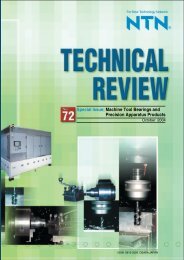
![[New Product] Unit Products for Office Equipment - NTN](https://img.yumpu.com/27154451/1/184x260/new-product-unit-products-for-office-equipment-ntn.jpg?quality=85)
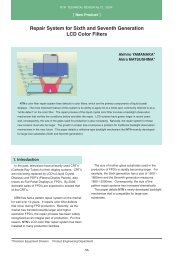
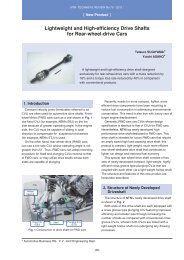
![[New Product] Development of Oil-impregnated Sintered ... - NTN](https://img.yumpu.com/27154427/1/184x260/new-product-development-of-oil-impregnated-sintered-ntn.jpg?quality=85)

